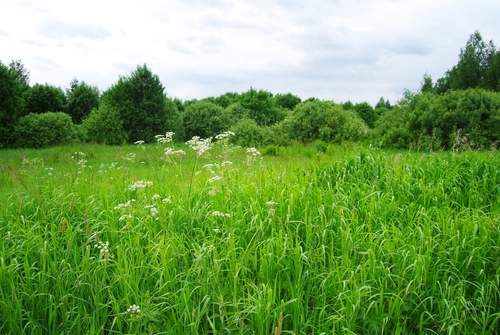Clearing overgrown land can seem like a daunting task, but with the right approach, it becomes manageable and even satisfying. The most effective way to tackle overgrown land is to start with the big stuff like trees and large bushes, using tools such as chainsaws or brush cutters. From there, you can move on to smaller vegetation, using hand tools like shovels and pruning shears to clear the remaining brush and roots.
It’s essential to prepare adequately before diving into the work. Assess the area, plan your approach, and gather the necessary tools. Renting a yard waste dumpster can significantly simplify the task of disposing of the overgrown brush and natural waste, ensuring your cleanup is efficient and environmentally friendly.
With your plan and tools in place, you can systematically tackle the overgrown yard cleanup, transforming your property into a usable and attractive space. Remember, the key is to take it step by step, dealing with each obstacle methodically, whether it’s stubborn roots, rocks, or dense vegetation.
 Successfully clearing overgrown land involves removing various types of vegetation, including weeds, grasses, trees, and shrubs. Disposing of the plant waste properly is also crucial to maintaining a clean environment and preventing regrowth.
Successfully clearing overgrown land involves removing various types of vegetation, including weeds, grasses, trees, and shrubs. Disposing of the plant waste properly is also crucial to maintaining a clean environment and preventing regrowth.
 Effective soil preparation and strategic landscaping are essential for transforming overgrown land into a productive and attractive area. You’ll need to focus on tilling the soil and designing the landscape to suit your needs.
Effective soil preparation and strategic landscaping are essential for transforming overgrown land into a productive and attractive area. You’ll need to focus on tilling the soil and designing the landscape to suit your needs.
 When clearing overgrown land, ensuring environmental compliance is crucial. It involves adhering to various legal standards to maintain ecosystem integrity.
When clearing overgrown land, ensuring environmental compliance is crucial. It involves adhering to various legal standards to maintain ecosystem integrity.
 Construction and Demolition Recycling Association: Advancing Sustainable Practices in the Industry
Construction and Demolition Recycling Association: Advancing Sustainable Practices in the Industry
Date: September 11 ,2024
Key Takeaways
- Start by removing large vegetation before tackling smaller brush.
- Proper preparation and the right tools are essential for efficient land clearing.
- Renting a yard waste dumpster aids in the efficient disposal of natural waste.
Preparing for Land Clearance
Before clearing overgrown land, it’s crucial to examine the area to identify obstacles and create a detailed plan to manage the process efficiently and safely.Assessing the Property
Start by walking through the property to gain a thorough understanding of the terrain and vegetation. Identify obstacles such as large rocks, trees, and dense brush. Take note of any hazards like steep slopes or water features. You may need to consult local regulations to determine if a permit is required for specific types of land-clearing activities. Verify property boundaries to avoid any disputes with neighbors. Take photographs to document the initial state of the land, which can be helpful for future reference.Creating a Clearing Plan
Once you have assessed the property, create a detailed clearing plan. Divide the land into sections and determine the priority areas for clearing. This organized approach helps manage the workload and ensures that you tackle the most critical areas first. Prepare a list of tools and equipment needed, such as shovels, chainsaws, and possibly a brush mower for larger areas. Consider safety precautions, including wearing protective gear like gloves, goggles, and sturdy boots. Estimate the time required for each section and set achievable goals to maintain progress. If heavy equipment is needed, factor in rental costs and availability. Ensure you have contingency plans for dealing with unforeseen obstacles or delays.Choosing the Right Tools and Equipment
To clear overgrown land effectively, it’s critical to select the right tools and equipment suited to the specific tasks and the size of the area. Below, we’ll cover hand tools and power tools for precise work and heavy equipment for larger areas.Hand Tools and Power Tools
For more detailed tasks, hand tools and power tools can be incredibly effective. Hand tools such as shovels, rakes, and pruners allow you to clear small rocks, roots, and branches. A brush grubber is excellent for pulling out small trees and stumps. Power tools like chainsaws and string trimmers take efficiency to the next level. A chainsaw will help you cut through thick branches and trees, while a string trimmer is useful for trimming grass and smaller brush. For stubborn stumps, a stump grinder ensures complete removal and prevents regrowth.Heavy Equipment for Larger Areas
For clearing larger areas, heavy equipment is indispensable. A tractor equipped with a brush mower can cover large expanses efficiently. Brush mowers are perfect for cutting through dense, overgrown vegetation quickly. When dealing with uneven terrain, a bulldozer or crawler bulldozer is ideal for pushing, digging, and leveling earth. These machines are particularly useful for extensive land clearing projects where precision and power are needed. Another versatile option is an excavator, which uses its bucket arm to remove large debris and dead trees, making it a go-to for significant clearing tasks.Clearing Vegetation
 Successfully clearing overgrown land involves removing various types of vegetation, including weeds, grasses, trees, and shrubs. Disposing of the plant waste properly is also crucial to maintaining a clean environment and preventing regrowth.
Successfully clearing overgrown land involves removing various types of vegetation, including weeds, grasses, trees, and shrubs. Disposing of the plant waste properly is also crucial to maintaining a clean environment and preventing regrowth.
Removing Weeds and Grasses
To start, focus on weeds and grasses. Use hand tools like hoes, shovels, and rakes to uproot these plants. Consistent removal helps prevent regrowth. For larger areas, consider using a self-propelled brush mower, which can efficiently handle dense grasses and weeds. Manual removal is labor-intensive but effective for small plots. Ensure you dig out the roots to stop them from re-sprouting. Chemical herbicides can be an option, but only if they comply with environmental regulations and safety guidelines. Mulching the area can also help suppress new weed growth.Cutting Down Trees and Shrubs
Larger vegetation like trees and shrubs need different tools. Small trees and saplings are best removed with a sharp spade or hatchet. For trunks less than 2 inches in diameter, you can dig around the plant to expose the root structure and cut the roots with a hatchet. Chainsaws and brush cutters are necessary for larger trees and shrubs. Safety gear, including gloves, goggles, and helmets, is essential when using these tools. If the trees are too large, professional tree removal services should be considered to avoid accidents.Disposing of Plant Waste
Once the vegetation is cleared, proper disposal of plant waste is critical. Smaller debris like weeds and grasses can be composted or mulched. Grass clippings and small plant parts make excellent mulch, enriching the soil with nutrients. For larger branches and tree trunks, a wood chipper can be used to turn this waste into wood chips. These chips can be used for landscaping or as mulch. For large amounts of waste, renting a dumpster or hiring a professional disposal service may be necessary to keep the area clean and ready for future use.Dealing with Difficult Obstacles
Tackling overgrown land involves removing stubborn elements like stumps, roots, rocks, and woody brush. Effective use of tools and specific strategies can aid in managing these challenges efficiently.Extracting Stumps and Roots
Removing stumps and roots can be labor-intensive but manageable with the right approach. For smaller stumps, you can use a shovel and root saw to dig around and cut through the larger roots. Leverage the root ball out of the ground with a pry bar. For larger stumps, consider using a chainsaw to cut the stump close to ground level before digging it out. Alternatively, a stump grinder can chip away the stump gradually. Remember to cut and remove any major roots as you go to ensure you fully extract the stump and root system.Managing Rocks and Woody Brush
When dealing with rocks and woody brush, start by identifying the size and quantity of each. For rocks, use a rock bar or shovel to pry and lift them out of the soil. For larger boulders, you may need a winch or mechanical assistance. Clearing woody brush involves using tools like a brush cutter or string trimmer. These tools can effectively chop down thick vegetation and small trees. For thick and hard-to-reach areas, a chainsaw may be necessary to cut through larger branches and trunks. Wear protective gear to avoid injury from sharp branches and debris.Soil Preparation and Landscaping
 Effective soil preparation and strategic landscaping are essential for transforming overgrown land into a productive and attractive area. You’ll need to focus on tilling the soil and designing the landscape to suit your needs.
Effective soil preparation and strategic landscaping are essential for transforming overgrown land into a productive and attractive area. You’ll need to focus on tilling the soil and designing the landscape to suit your needs.
Tilling and Conditioning the Soil
Start by removing any large debris like rocks and roots using tools such as shovels and rakes. Then use a rototiller to break up and aerate the soil. This process not only loosens compacted soil but also incorporates organic matter like compost. Mixing in compost adds essential nutrients and improves soil structure. If you plan to grow a garden, consider testing the soil for pH levels and nutrient deficiencies. Amend the soil accordingly with lime or sulfur to balance pH and apply fertilizer to address nutrient shortages. Using a tiller, make multiple passes over the land to ensure even soil distribution and better root penetration for plants. Aim for a fine, crumbly soil texture, which is optimal for planting.Designing the Landscape
First, sketch a rough design of your landscape, including pathways, plant beds, and any structures like sheds or benches. Choose plants that thrive in your soil type and climate. Group plants with similar water, sunlight, and soil requirements to simplify irrigation and maintenance. Incorporate both functional and aesthetic elements. For instance, raised beds can be both attractive and beneficial for improving soil drainage. Mulching around plants helps retain soil moisture and prevent weed growth. Planting perennials and native species can reduce maintenance while providing long-term stability to your landscape. Consider using a mix of trees, shrubs, and ground covers to create layers of vegetation, enhancing both visual appeal and ecosystem health.Fencing and Protecting the Land
When clearing overgrown land, it’s important to protect your property with appropriate fencing and maintain clear boundaries.Installing New Fences
Installing new fences is crucial to defining your property lines and keeping unwanted elements out. Begin by marking the exact boundaries of your property. You can use stakes and string to outline the areas where the fence will be installed. Choose the right material for your fence. Common options include wood, metal, and vinyl. Wood fences provide a natural look but require more maintenance. Metal fences, such as chain link, are durable and low maintenance. Vinyl fences are both low maintenance and aesthetically pleasing. After choosing the material, dig post holes at regular intervals. Typically, you should place posts 6-8 feet apart. Use a post hole digger to ensure each hole is deep enough. Insert the posts and fill the holes with concrete to stabilize the structure. Once the posts are set, attach the fencing material securely.Maintaining Boundaries
Maintaining boundaries is essential to ensure the longevity and functionality of your fences. Regularly inspect your fences for any signs of damage or wear. Look for broken boards, rusted wires, or leaning posts, and address these issues promptly. Clear vegetation along the fence lines to prevent overgrowth from damaging the structure. Use landscaping tools like trimmers or mowers to keep plants at bay. If using herbicides, choose products safe for the environment and surrounding vegetation. Additionally, check that your property lines remain clearly marked. Over time, markers can become obscured or displaced. Reinforce boundary markers with durable materials such as metal or treated wood stakes. Ensure these markers are visible and not easily removed or damaged. Maintaining clear boundaries helps prevent disputes and protects your land effectively.Environmental Considerations and Compliance
 When clearing overgrown land, ensuring environmental compliance is crucial. It involves adhering to various legal standards to maintain ecosystem integrity.
When clearing overgrown land, ensuring environmental compliance is crucial. It involves adhering to various legal standards to maintain ecosystem integrity.
Legal Regulations
Each region has specific regulations regarding land clearing. For instance, South Carolina addresses habitat preservation and stormwater management. Familiarize yourself with local, state, and federal guidelines to avoid fines and liabilities.Chemical Solutions and Herbicides
Using chemical solutions and herbicides can be effective, but they must be applied responsibly. Select eco-friendly products to minimize soil and water contamination. Compliance with local environmental protection standards is essential to prevent harmful impacts on biodiversity.Land and Plant Preservation
Preserve native plants and wildflowers to support local biodiversity. Clearing should be done methodically, allowing for the recovery of beneficial species.Moisture Management
Monitor moisture levels during land clearing. Excessive soil disturbance can lead to erosion and water pollution. Implement stormwater management techniques to safeguard waterways.Tree Preservation
Be mindful of tree preservation laws. Certain regions require permits for removing trees, especially if they are part of protected species. By following these guidelines, you can clear overgrown land effectively while maintaining environmental compliance. More details can be found in the guide to land clearing in South Carolina and an in-depth guide to land clearing for a broader understanding.Maintenance and Prevention
Regular upkeep of your land and taking measures to prevent future overgrowth are pivotal. Implementing effective strategies can save you time and effort while ensuring your land remains in prime condition.Regular Upkeep Strategies
Maintaining overgrown land requires a consistent routine. Mowing your lawn regularly helps keep grass and weeds from getting out of control. Investing in a quality lawn mower can make this task manageable. Mulching is also beneficial as it helps to retain soil moisture and suppress weed growth. Using a combination of hand tools and motorized equipment allows you to keep shrubs and small trees in check. Pruning and trimming branches before they become a problem keeps the overall appearance neat. Lastly, utilizing herbicides can prevent the regrowth of unwanted plants, but ensure to follow safety guidelines to avoid damage to desirable vegetation.Preventing Future Overgrowth
Preventing future overgrowth begins with smart planning. Choose native plants and grasses that require minimal care and are less likely to become invasive. Mulching not only aids in maintenance but also discourages weed germination. Another tactic is the timely sowing of seeds, particularly of ground-cover plants that outcompete weeds for sunlight and nutrients. Creating physical barriers such as edging or fencing around garden beds can help prevent encroachment of grass and weeds. Additionally, regularly inspecting your property for early signs of trouble allows for quick intervention, preventing minor issues from escalating. Establishing thick, healthy turf can further choke out potential weeds, minimizing the need for chemical intervention.Frequently Asked Questions
This section addresses common queries on the most cost-effective methods, essential tools, optimal seasons, and practical steps for clearing overgrown land. Here, you will find concise answers to help you undertake the task efficiently.What is the most cost-effective way to clear an overgrown yard?
Using hand tools like shovels and mattocks can be cost-effective if you have time and energy. Additionally, creating a plan and budget before starting helps in minimizing unnecessary expenses.Which tools are essential for manually clearing thick underbrush?
Essential tools include shovels, mattocks, and sharp spades. A hatchet is also useful for cutting through roots and small trunks.When is the optimal season to undertake the clearing of overgrown land?
Clearing land is best done in late fall or early spring. During these seasons, vegetation is either dormant or just beginning to grow, making it easier to remove.What methods are available for clearing land without the use of heavy machinery?
Hand tools and brush mowers are effective for clearing land without heavy machinery. Woody plants and shrubs can be dug, hacked, or pulled out if they are small enough.How can one remove dense vegetation from a yard without incurring costs?
You can remove dense vegetation by manually cutting and pulling weeds, grasses, and small shrubs. Utilizing free resources like community tool banks can also help reduce costs.What steps should be followed to efficiently clear brush and small trees?
First, create a plan and budget. Then, use sharp tools to dig around plants to understand the root structure. Sever roots with a hatchet or spade, and remove debris as you clear.RECENT BLOGS
 Construction and Demolition Recycling Association: Advancing Sustainable Practices in the Industry
Construction and Demolition Recycling Association: Advancing Sustainable Practices in the Industry
Date: September 11 ,2024
Our Reviews
Mark Ramick
1725926374
Amber was awesome in helping me schedule the right dumpster for my job. Thanks again
Brian Healy
1725553543
Heather was so very pleasant, informative and charming. Next time… I will use you again.
Brandi Childers
1724853716
Ricardo helped me with my reservation. He made everything super clear and answered all my questions to help me pick the right dumpster to rent!
Steven Hewett
1724785537
Heather made the sales and scheduling experience extremely easy. Thank you for having great employees that care about conducting great business.
Jackson Vandiver
1724703158
Great service and fantastic customer service department. I would use them again.





